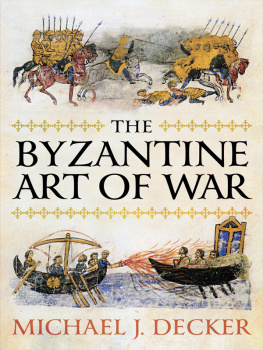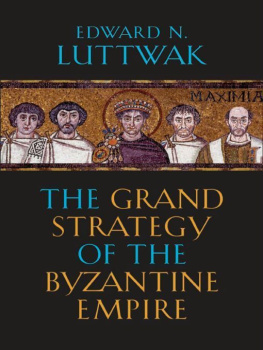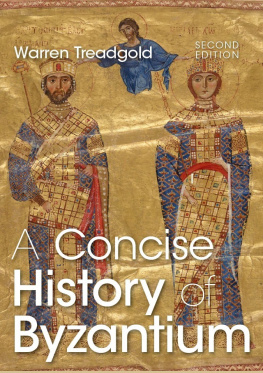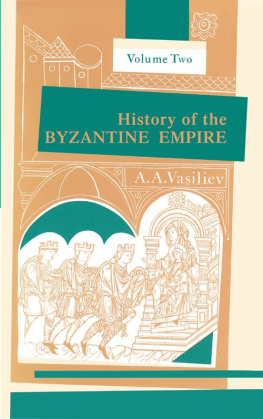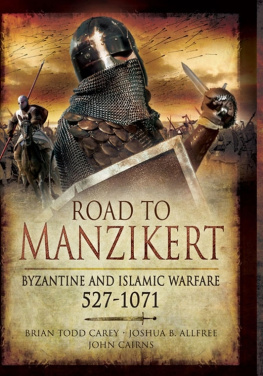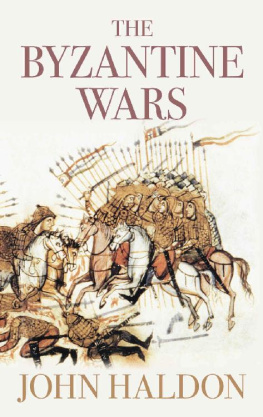MICHAEL J. DECKER
Frontispiece: Sixth century relief showing Roman troops of the V Macedonian legion. (Rheinisches Landesmuseum, Trier, Germany)
2013 Michael J. Decker
Maps by T. D. Dungan. 2013 Westholme Publishing
All rights reserved under International and Pan-American Copyright Conventions. No part of this book may be reproduced in any form or by any electronic or mechanical means, including information storage and retrieval systems, without permission in writing from the publisher, except by a reviewer who may quote brief passages in a review.
Also available in hardback.
Produced in the United States of America.
INTRODUCTION
ON MAY 29,1453, the twenty-one-year-old Ottoman Sultan Mehmed II led his 80,000-man army through the breach in the walls of the ancient capital of eastern Rome, Constantinople, where many of the 7,000 defenders lay dead. The dramatic assault, made possible by one of the earliest and most impressive displays of gunpowder artillery, punched through the hitherto impregnable fortifications, and led to the death of the last Byzantine emperor, Constantine XI Palaiologos, who perished in the assault; his body was never found. Greek legend holds that at the end of days, Constantine will return and rise from the floor of the great cathedral of Hagia Sophia in Istanbul to lead the Greek nation to final victory and the restoration of God's Roman Empire on earththe Christian Byzantine state. In the spring of 1453, though, the noose that finally strangled the last vestiges of Greek independent political life from the Balkans was long in the tightening. Since 1356 the Ottoman Turks had made Edirne, in eastern Thrace, their capital and steadily strengthened their hold on the empire's former European lands. The Byzantines had been fatally weakened by the sacking of the capital of Constantinople two and half centuries prior in 1204 by the Christian crusaders from the West. This date marks the effective end of Byzantium as a major military and pan-Mediterranean power; after the sack of the capital, Latin warlords and their Venetian allies partitioned the empire while disparate Byzantine rulers regrouped and attempted to mount an effective resistance. Either date, 1204 or 1453, is arguably an appropriate one for marking the end of the Roman Empire. Although for centuries prior to either conquest the vast majority of the empire's inhabitants spoke Greek, and we refer to them as Byzantines, they called themselves Romans and viewed their empire as the state once ruled by Augustus or Trajan. After all, they were the direct inheritors of the Roman Empire's territory in the eastern Mediterranean, continued its administrative and legal framework without interruption, and, most important for our purposes, relied on the military apparatus that evolved from the old Roman legionary armies of antiquity.
The most striking thing about the Byzantine military, and Byzantine society at large, was its remarkable longevity. These medieval Romans, with their Greek speech and Christian faith, clung tenaciously to their culture in the face of constant internal and external pressures. Warfare, although never embraced by the majority of Byzantines as a virtue in the way that many western peoples viewed it, was nonetheless an essential component of the Byzantine experience. Foreign enemies were constantly at the door and they came from all directions, especially at the end of the empire's existence, when westerners threatened the shrinking borders of the state as much as did eastern and northern peoples. It is impossible to find anything like the pax Romana of the emperor Augustus and his successors, when Rome presided over one of the more tranquil periods of European history, having slaughtered most serious foes and bloodily dispatched of entire races in the process. However it was won, no parallel time of quietude ever descended on the Byzantine realm. Although the citizens of the empire probably fully expected a period of peace following the end of the brutal, apocalyptic struggle with Persia in the 620s, their hopes were sorely dashed when the ravenous armies of Arabia descended on the eastern provinces and rent them from the imperial grasp forever. In a matter of decades the Arab foes and bearers of the kernel of a new religion, Islam, were battering at the gates of Constantinople itself, and the empire had lost most of its territory to the Arabs or other invaders.
The survival of the embattled state and its much-reduced armed forces is one of the miracles of history. Far outclassed in terms of manpower and wealth and subjected to military challengers on multiple fronts, the Roman Empire of Byzantium nevertheless survived the assaults they received in the Dark Ages and emerged with a transformed state and society. The army, for which the bureaucracy and its tax system existed, both absorbed the blows of its enemies and dealt more shocks through rebellions and internal discord that marked the seventh through ninth centuries. Despite the upheavals, societal trauma, and the loss of so much territory and manpower, the Byzantine army adapted and fought on. By the time the Macedonian dynasty, the greatest of the medieval empire, came to power in the form of the usurper Basil I (86786) the Byzantines were poised to embark on a two centuries-long program of expansion. Their reformed armies pushed the frontier into the borderlands of the caliph and reestablished Byzantium as the predominant power in the Mediterranean world. No state in European history absorbed such losses, survived, and revived to such prominence. At the center of this revival was the army, and the collective action of society, emperors, commanders, and soldiery make for one of the more compelling stories in world history.
In the pages that follow, I provide an overview of the basics of the medieval Roman army, including organization, logistics, armament, tactics, and strategy as well as delve into how these were employed. Although it is doubtful that the Byzantines ever thought of war in terms of grand strategy or professed military doctrines based on perceived universal experiences in war, one can clearly detect patterns to their approach to warfare with the benefit of hindsight. I call this the Byzantine Art of War.
THIS BOOK IS WRITTEN for a nonspecialist audience and students of military history and has been spurred by my own interest in the subject and by the enthusiasm for which my lectures on the topic at the University of South Florida have been received. In its crafting I am greatly indebted to the work of outstanding scholars the world over, especially John Haldon, who has pioneered much work on the Byzantine army, Timothy Dawson, Walter Kaegi, James Howard-Johnston, Taxiarches Kolias, Eric McGeer, Philip Rance, Dennis Sullivan, Warren Treadgold, and a host of other accomplished academics too numerous to mention. The reader wishing to know more will find the references necessary to pursue specific topics at their leisurefor this reason, and because I anticipate an audience whose primary language is English, I have endeavored to supply as many English-language secondary sources and translations as possible. I reference these in the notes. Original language sources may be found in the Abbreviations and Bibliography. Finally, in an effort to produce a text as unencumbered as possible, I have limited diacritics in transliterating foreign-language names, terms, and sources and restricted the number of notes. I trust that those who wish to explore the subject further will find the bibliography an adequate gateway into a vast and growing body of literature on Byzantine warfare.

